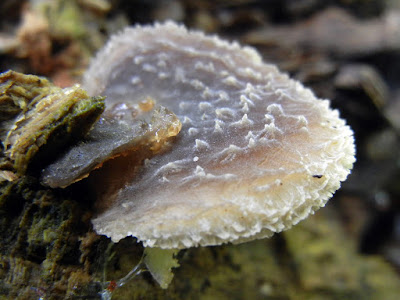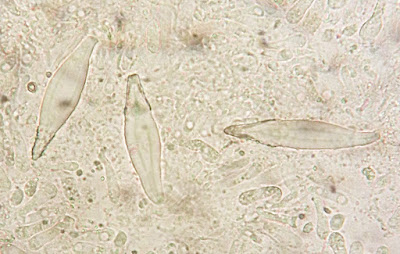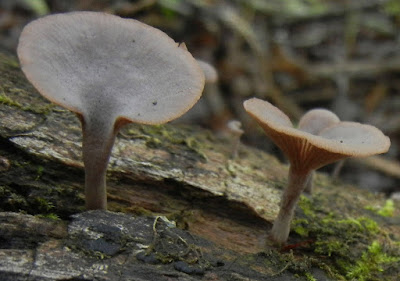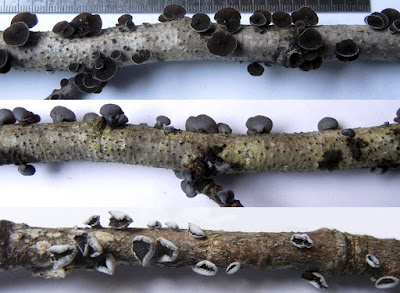 |
| Bolbitius callisteus - baby & young adult |
Bolbitius callisteus, a.k.a. B. callistus, is one of my favourite mushrooms – for a whole bunch of reasons. And edibility is not one of them.
Reason #1:
It's a trickster, in that it looks completely different at different stages of its existence. It starts out as a greenish button, with pale greenish yellow gills, then spreads into a licked butterscotch candy parasol – often the same day. If you find representatives of these different stages in different locations on different days, which seems to be the norm since they often grow solo, you'd be hard pressed to consider them to be the same character. At least, I was.
|
|
Young gills with green tones
|
 |
Even the stem of the young one has greenish-blue tones,
tones that can disappear in a matter of hours. |
 |
| Licked-candy stage |
 |
| It soon becomes heavily striate. |
 |
The caps of old specimens become conical. The stipe
also darkens, as do the gills as they're
coloured by reddish brown spores.
|
In the plant world, coltsfoot is a classic example of such trickery, though this wildflower/herb takes it a step further – or maybe backwards. First it produces dandelionish flowers that push up from the ground in early spring without any sign of accompanying leaves. Only later, after the flowers have withered away, do the oversized
leaves finally break through the soil and unfurl. An old name for it was actually Filius ante patrem – son before father.
 |
Since Coltsfoot (Tussilago farfara) flowers and leaves appear at
separate times, you'd be forgiven if you thought they were two
different species. (Photos: left Andreas Trepte, right Wikipedia) |
Reason #2:
Bolbitius callisteus has an affinity for growing on fallen hardwood limbs and branches that have been water saturated for part of the year. The best place to find these branches is in vernal pond areas.
Vernal ponds are spring ponds, fed by snowmelt and rain, but without any outflow. I'm fond of these ponds and the dips in the forest that are revealed when the water evaporates or soaks in. They're the chameleons of the forest ecosystem. In April, they're like any other spring pond, attracting ducks during migration. In May they're all quacky – not with ducks, but with the mating calls of wood frogs. Because these ponds usually appear in low, poorly drained areas, the soil has a tendency to remain moist long after visible water has disappeared. Even during droughts – which are becoming more and more common in southern Ontario – these areas continue to produce fruiting fungi.
 |
| Vernal pond in April |
 |
| Vernal pond in early March after a dry winter |
 |
| A different March vernal pond |
 |
| Vernal pond in May |
 |
| Vernal pond in June |
 |
Centre of a large vernal pond in September (with leaping Ruby)
 |
Vernal pond in October – note the
spring waterline on the tree trunks |
|
Reason #3
Bolbitius callisteus is supposed to be very rare. Asterotus/Resupinatus dealbutus, which I wrote about a couple of months ago, was also found in vernal pond areas and is also rare. I like finding "rare" fungi since they usually don't show up in field guides, which makes them a challenge to identify. Dried up vernal ponds are a great place to look for rarities. Here's a selection of my local ones:
 |
The aforementioned Asterotus/
Resupinatus dealbatus that has its own post. |
 |
Arrhenia retiruga. The middle specimen is upside
down, showing its gill-less fertile surface. |
 |
| Hygrocybe coccineocrenata ss. auct. amer. |
 |
| Baeospora myriadophylla |
I question, though, whether these fungi are actually really rare, or simply rarely collected. Human-made paths normally, and sensibly, skirt around seasonally flooded areas, so maybe these areas are just not as frequently scoured by collectors. They can be certainly be unappealing areas when prickly ash is involved (I have thorn scars to prove it).
Reason #4
I have a soft spot for wrinkles and reticulation, and not only on mushrooms. I have always loved the wrinkles of my straightened elbow, and of the straightened elbows of people I love. So pliable! So playable! So hard to see (on myself)! And the caps of Bolbitius callisteus, when young, are wrinkled and/or reticulate (netted or veined).
 |
| Bolbitius casteneus is wrinkled, though often not spectacularly so. |
Fungal wrinkles and reticulation are not uncommon. Lots of boletes, including a number of choice ones, have reticulation on their stipes that can help in their identification.
 |
Boletus chippewaensis, my local King Bolete, can
have anything from a light netting at the very top of its stem
to head-to-toe reticulation, like a crinoline glued to it. |
 |
The queen of the boletes with reticulate stems has to
be Frostiella russellii/Boletellus russellii
with her deeply carved reticulation. |
 |
A friend said its stem looked like a Cadbury Flake bar.
I knew there was something in my past that made me salivate
the first time I found a Russell's Bolete! |
But what I like most are mushroom caps that have wrinkles or reticulation – like the cap of Boletus callisteus's brother, B. reticulatus, which is named for this phenomenon.
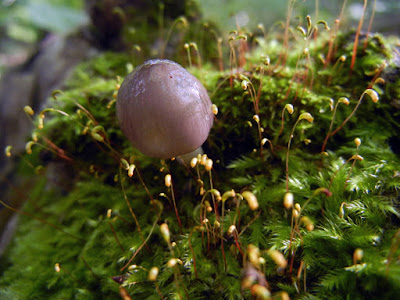 |
| Bolbitius reticulatus often has a pretty violet tones. |
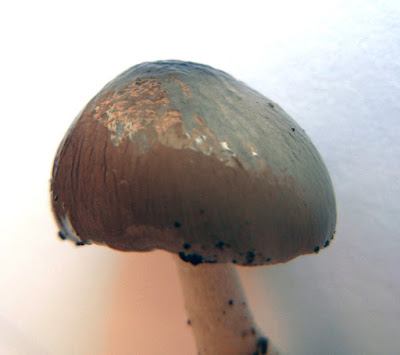 |
The cap of B. reticulatus is covered with a viscous coating that
makes it hard to photograph its wrinkles. See Mycoquebec
for much better images and full description. |
 |
Like B. callisteus, B. reticulatus becomes strongly
translucent striate as it opens. |
 |
| Sometimes there are no violet tones at all. |
Cap wrinkles are also common in many Pluteus species (pink-spored, free-grilled mushrooms that grow on wood).
 |
| Pluteus granularis with guttation-droplet jewellery |
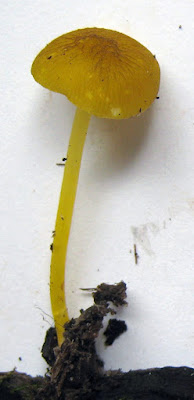 |
| Pluteus chrysoplebius can be deeply wrinkled when young. |
 |
| Pluteus thomsonii – the prince of Pluteus reticulation |
Here's a few more:
 |
| Psathyrella delineata – The Wrinkled Cap Psathyrella |
 |
| The Gypsy Mushroom – Cortinarius caperatus |
And I'd be remiss not include the craziest reticulate cap of Rhodotus palmatus:
Reason #4
Pure aesthetics. I think this mushroom is gorgeous. I can never resist taking out my camera.
Unless otherwise noted, all photographs © Jan Thornhill




















































